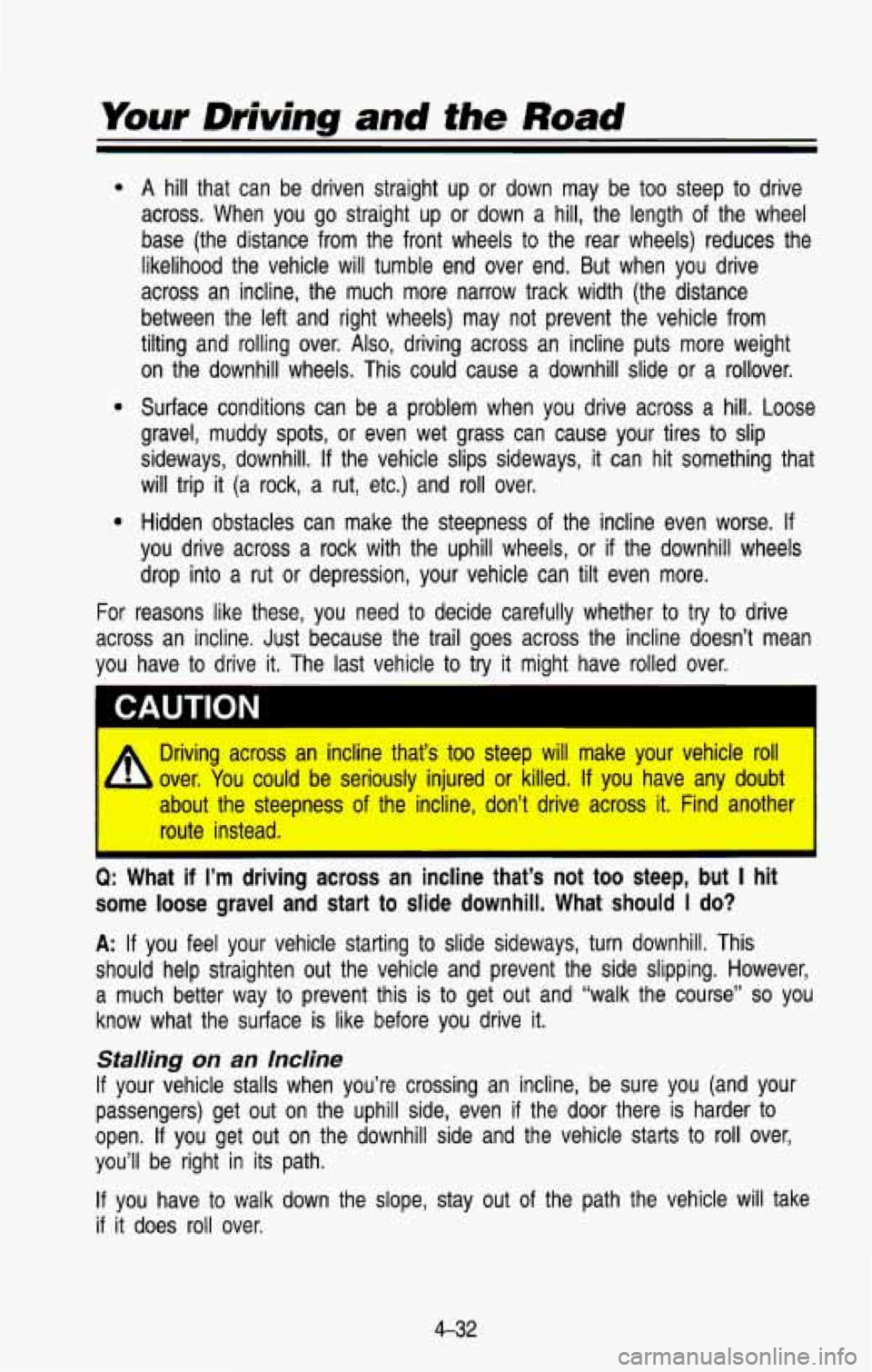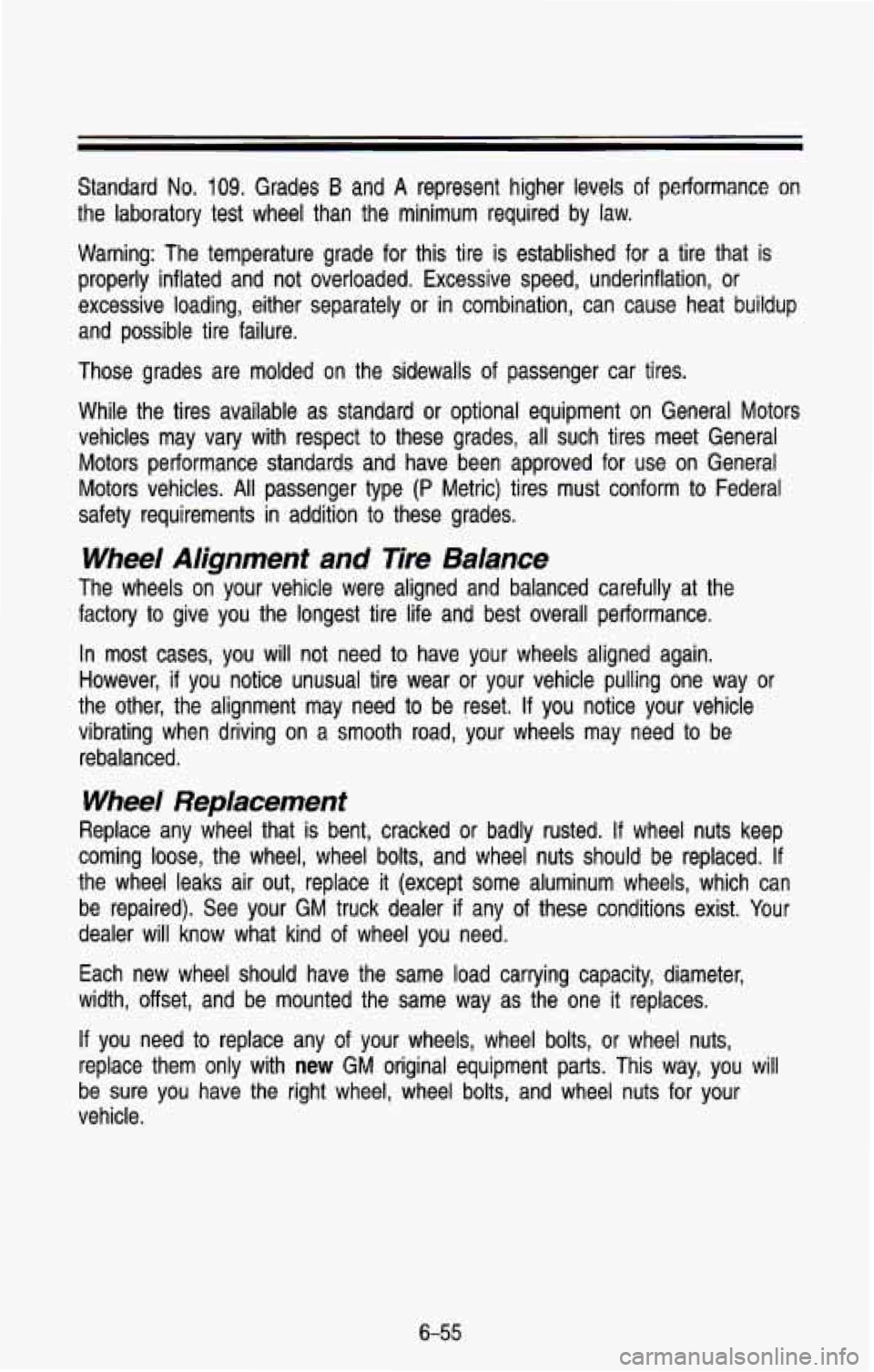Page 38 of 386
Q: What’s wrong with this?
AM125002
A: The belt is twisted across the body.
I CAUTION
You can be seriously injured by a twisted belt, In a crash, you
wouldn’t have the full width of the belt to spread impad forces. If a
belt is twisted, make it straight so it can work properly, or ask your
1 dealer to fix a.
1
.- . r-
AN120123
To unlatch the belt, just push the button on the buckle. The belt should go
back out of the way.
1-25
Page 199 of 386

Your Driving and the Road
0
0
For
A hill that can be driven straight up or down may be too steep to drive
across. When you go straight up or down a hill, the length o\
f the wheel
base (the distance from the front wheels to the rear wheels) reduces the
likelihood the vehicle will tumble end over end. But when you drive
across an incline, the much more narrow track width (the dist\
ance
between the left and right wheels) may not prevent the vehicl\
e from
tilting and rolling over.
Also, driving across an incline puts more weight
on the downhill wheels. This could cause a downhill slide
or a rollover.
Surface conditions can be a problem when you drive across a
hill. Loose
gravel, muddy spots, or even wet grass can cause your tires to slip
sideways, downhill.
If the vehicle slips sideways, it can hit something that
will trip
it (a rock, a rut, etc.) and roll over.
Hidden obstacles can make the steepness
of the incline even worse. If
you drive across a rock with the uphill wheels, or if the do\
wnhill wheels
drop into a rut or depression, your vehicle can tilt even more.
reasons like these, you need to decide carefully whether to try to drive
across an incline. Just because the trail goes across the incline doesn’t mean
you have to drive it. The last vehicle to try it might have rolled over.
CAUTION
A
Driving across an incline that’s too steep will make your vehicle roll
over. You could be seriously injured or killed.
If you have any doubt
about the steepness of the incline, don’t drive across it. \
Find another route instead.
I
Q: What if I’m driving across an incline that’s not too steep, but I hit
some loose gravel and start
to slide downhill. What should I do?
A: If you feel your vehicle starting to slide sideways, turn down\
hill. This
should help straighten out the vehicle and prevent the side sl\
ipping. However, a much better way to prevent this is to get out and “walk the course”
so you
know what the surface is like before you drive
it.
Stalling on an Incline
If your vehicle stalls when you’re crossing an incline, be sure you (and your
passengers) get out on the uphill side, even
if the door there is harder to
open.
If you get out on the downhill side and the vehicle starts to roll over,
you’ll be right in its path.
If you have to walk down the slope, stay out of the path the vehicle will take
if it does roll over.
4-32
Page 320 of 386

Standard No. 109. Grades B and A represent higher levels of performance on
the laboratory
test wheel than the minimum required by law.
Warning: The temperature grade for this tire is established for a tire that is
properly inflated and not overloaded. Excessive speed, underinfla\
tion, or
excessive loading, either separately or in combination, can cause heat buildup
and possible tire failure.
Those grades are molded on the sidewalls of passenger car tires.
While the tires available as standard or optional equipment on \
General Motors
vehicles may vary with respect to these grades, all such tires meet General
Motors performance standards and have been approved for use on General
Motors vehicles.
All passenger type (P Metric) tires must conform to Federal
safety requirements in addition to these grades.
Wheel Alignment and Tire Balance
The wheels on your vehicle were aligned and balanced carefully \
at the
factory to give you the longest tire life and best overall performance.
In
most cases, you will not need to have your wheels aligned again.
However,
if you notice unusual tire wear or your vehicle pulling one way or
the other, the alignment may need to be reset.
If you notice your vehicle
vibrating when driving on a smooth road, your wheels may need to be
rebalanced.
Wheel Replacement
Replace any wheel that is bent, cracked or badly rusted. If wheel nuts keep
coming loose, the wheel, wheel bolts, and wheel nuts should be\
replaced.
If
the wheel leaks air out, replace it (except some aluminum whe\
els, which can be repaired). See your GM truck dealer
if any of these conditions exist. Your
dealer will know what kind of wheel you need.
Each new wheel should have the same load carrying capacity, di\
ameter,
width, offset, and be mounted the same way as the one it replaces.
If you need to replace any of your wheels, wheel bolts, or wheel nuts,
replace them only with
new GM original equipment parts. This way, you will
be sure you have the right wheel, wheel bolts, and wheel nuts\
for your
vehicle.
6-55